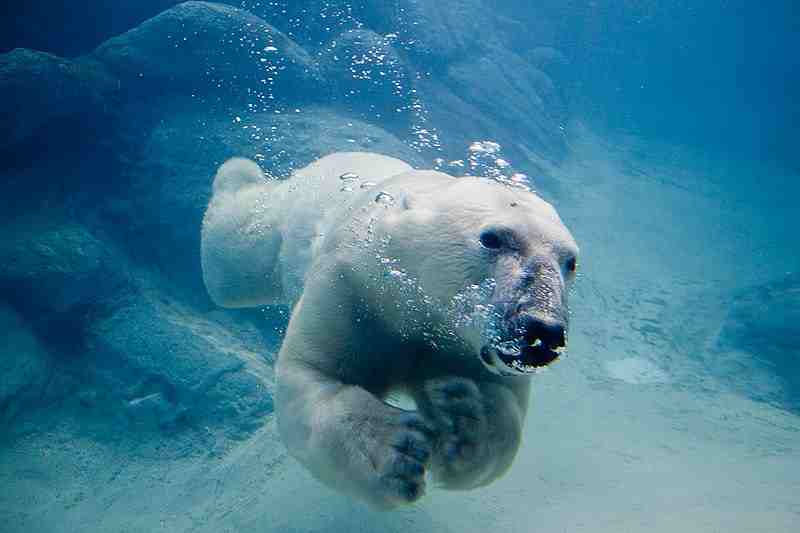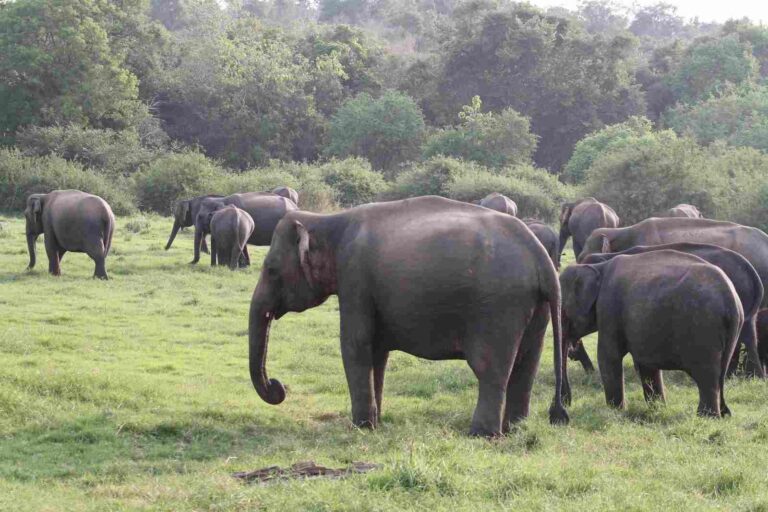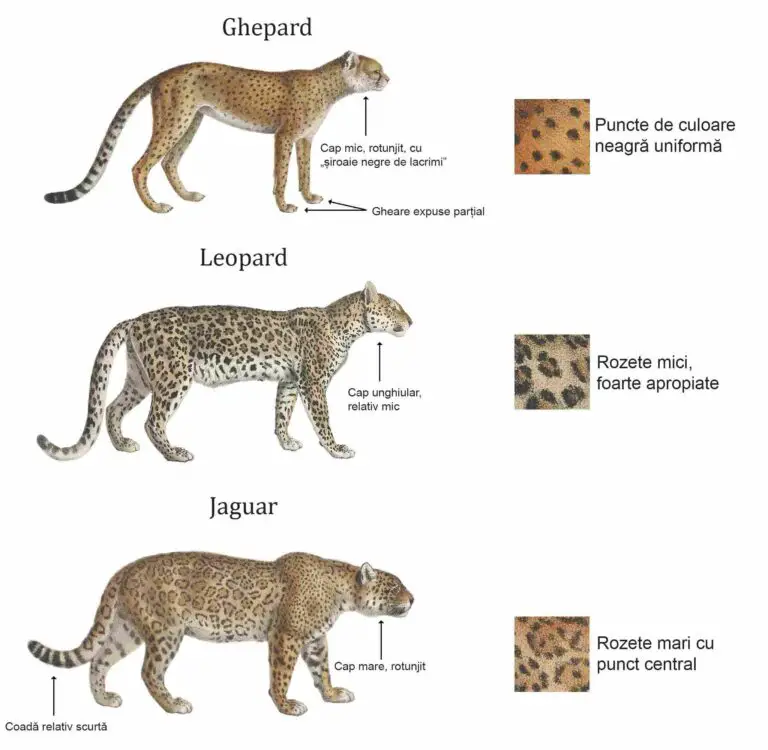Tundra Energy Pyramid with Trophic Levels Discussed
Tundra energy pyramid is made up of; producers like moss, primary consumers like voles, secondary consumers like Arctic fox, and tertiary consumers like polar bear; as well as the energy-transfer dynamics between them.
This article discusses the tundra energy pyramid model, with its trophic levels and their respective occupants, as follows;
1). Tundra Primary Producers (as a trophic level of the Tundra Energy Pyramid)
Hypothetical Total Bioenergy- 10,000 kJ
Primary producers in the tundra ecosystem, are crucial with regards to their role in energy transfer from one trophic level to another.
These organisms are capable of capturing and transforming solar energy into biomass, through the process of photosynthesis [4].
Primary producer in the tundra are mainly vascular and non-vascular plants, which have developed various adaptations to withstand the harsh tundra climate, nutrient deficiency of the soil, and other biotic as well as abiotic constraints.
Examples of tundra plants (that is; primary producers) are; dwarf trees, shrubs, sedges, forbs, grasses, and mosses.
*Dwarf Trees and Shrubs as Primary Producers in the Tundra Energy Pyramid
Dwarf trees and shrubs are physiologically similar groups of plants that occur in the tundra.
They both have woody stems; and tend to grow larger than other types of vegetation in the tundra.
Examples of shrubs in the tundra are; dwarf birch, and willow.
Trees are less common, because the dry and cold conditions are unfavorable for their survival. However, some species like the alder can be seen in transitional zones (also called the tree line) where the tundra meets the boreal forest.
As producers, dwarf trees and shrubs in the tundra supply usable chemical energy to the ecosystem from the synthesis of inorganic materials (including visible light from the Sun, and carbon dioxide).
They also serve as shelter and microhabitat to some tundra organisms.

*Sedges, Forbs and Grasses as Primary Producers in the Tundra Energy Pyramid
Sedges, forbs and grasses can all be classified as herbaceous plants, because they do not have woody tissues like shrubs.
In the tundra, these plants are fairly adaptive and prominent, contributing to the overall primary productivity of their environment.
Their survival in tundra regions can be attributed to evolutionary developments that enable these plants to maximize the brief supply of sunlight and nutrients for growth during summer; as well as to tolerate the prolonged period of extreme cold that represents winter in the tundra.
Biomass and energy produced by these plants are consumed by herbivorous tundra animals like lemmings and caribou.

*Tundra Mosses and Lichens as Primary Producers in the Energy Pyramid
The energy pyramid of the tundra also accommodates non-vascular bryophytes like mosses, as producers.
Like vascular plants, mosses are fairly efficient at photosynthesis, and capture solar energy to produce food for the ecosystem.
Lichens are not plants; but are rather symbiotic entities produced by the union and biological cooperation of an autotroph like algae, and a fungus [2]. In the tundra, lichens grow on soil and rock surfaces, and play a role in the supply of bioenergy from photosynthetic conversion.
The hypothetical total energy for producers in this tundra energy pyramid, is 10,000 kJ; which is from photosynthesis, and stored in the cells of producers in trophic level 1.
As a rule, approximately 90% of total bioenergy is lost as it is transferred from a given level to the next (that is; the underlying level) [6]. This loss can be attributed to metabolic activities that waste energy in the form of heat and inorganic chemical byproducts.
Given the condition described above, trophic level one (producers) contains the highest amount of energy in the pyramid. One transferring to trophic level two (2), about 9,000 kJ (90 percent) of this energy is lost; so that 1,000 kJ of total bioenergy will be available to primary consumers.
2). Tundra Primary Consumers
Hypothetical Total Bioenergy- 1,000 kJ
Tundra primary consumers are vital in the role which they play within the energy-dynamic system of their biome, where they occupy the second trophic level; feeding directly on primary producers to obtain energy and nutrients.
Primary consumers in the tundra also form an important link with organisms in higher trophic levels, that are unable to rely on producers as a (sole) source of food. For these higher organisms; the primary consumers act as a bridge across which energy from producers can be received in a palatable form.
Examples of primary consumers in the tundra are; herbivorous mammals, birds and insects.
*Herbivorous Mammals as Primary Consumers in the Tundra Energy Pyramid
Herbivorous mammals in the tundra constitute a prominent group of primary consumers.
They range from small rodents to large ruminant; and include individual species that have evolved and adapted to the prevalent conditions of tundra regions.
Rodents like voles and lemmings are herbivorous, mammalian primary consumers in the tundra. The same can be said of muskoxen and caribous.

Mammalian herbivores in tundras have digestive specializations for surviving on a plant-based diet, as well as to extract nutrients from the types of plants that grow in this biome.
They may exhibit migratory behavior and other seasonally-driven adaptations to increase their survival rate; and serve as food for carnivorous animals in the tundra.
*Herbivorous Birds in the Tundra
Examples of herbivorous birds in the tundra are; grouse and ptarmigan [1].
Food for these birds comprises of berries, seeds, leaves and buds, among other forms of plant matter.
Like their mammalian counterparts, they have specialized digestive tracts and distinctive beaks to enable them function effectively as primary consumers.

*Herbivorous Insects as Primary Consumers in the Tundra Energy Pyramid
Insects that are herbivorous in the tundra include moths and flies; which feed on flower nectar and other forms of vegetative matter.
Only few insects can survive in the tundra or its transitional margins; because of the extreme cold and low humidity. These insects are important as pollinators, as well as food sources for insectivorous tundra animals like birds.
*Energy Budget and Dynamics of Primary Consumers
About 1,000 kJ is the hypothetical amount of energy available to primary consumers in the energy pyramid being discussed in this article.
The 1,000 kJ represents 10% left from the total energy (10,000 kJ) available to producers; with 90% being lost to inefficient biodegradation, metabolism, and other processes.
Primary producers will acquire the energy available to them through grazing, detrivorous feeding and nectar-feeding.
3). Tundra Secondary Consumers (as a trophic level of the Tundra Energy Pyramid)
Hypothetical Total Bioenergy- 100 kJ
Secondary consumers in the tundra are critical toward energy flow, and occupy the third trophic level where they feed mainly on primary consumers.
Ideally, secondary consumers are carnivores that cannot consume plant matter, although some of them are highly adaptable and can adopt an omnivorous diet to supplement their primary food sources.
By preying on animals in lower trophic levels, they contribute to the establishment of sustainable ecological structures, and the temporal dynamics of food supply.
Examples of secondary consumers in the tundra energy pyramid are; predatory insects, raptors, carnivorous mammals and large fish (which live in aquatic micro-habitats like lakes and ponds- within the tundra).
*Predatory Insects as Secondary Consumers in the Tundra Energy Pyramid
Some insects like damselflies and dragonflies may be found in the tundra during summer.
These insects exhibit predatory carnivorous tendencies, and can consume smaller insects among other invertebrates.
*Raptors as Secondary Consumers in the Tundra Energy Pyramid
Raptors like peregrine falcons and snowy owls can be found in the tundra [3].
These birds prey directly on primary consumers like voles, as well as insects and other birds.
Adaptations that help them play their role efficiently include; talons, curved beaks, and keen eyesight.
Feeding activities of raptors help to regulate the population and distribution of primary consumers in the tundra energy pyramid; in such a manner that establishes sustainability.

*Carnivorous Mammals in the Tundra
Carnivorous mammals in the tundra like foxes and wolverines are secondary consumers.
They facilitate energy flow by feeding on birds and herbivorous mammals, as well as vulnerable carnivores.
Adaptive features of these animals include hunting skill, camouflage, keen sensitivity, and cold-tolerance.
*Large Fish as Tundra Secondary Consumers
Large fish that inhabit aquatic micro-habitats in the tundra, can function as secondary consumers, by feeding on smaller fish, birds, small mammals (that enter the water body) and invertebrates like insects.
Examples of fish that are predatory in the tundra region are; grayling, whitefish and Arctic char.
Predatory fish in the tundra are cold-tolerant, and may exhibit seasonal migratory behavior.
Their activities help to synchronize terrestrial and aquatic energy and nutrient cycling in the tundra.
Secondary consumers in the tundra energy pyramid, serve as food sources to apex predators; which occupy the fourth trophic level.
4). Tundra Tertiary Consumers
Hypothetical Total Bioenergy- 10 kJ
Tundra tertiary consumers may be found in trophic level four (4), which is also the highest trophic level of the energy pyramid for most tundra regions.
In the tundra, species richness is not high enough to produce a fifth trophic level, which would have been occupied by quaternary consumers.
Tertiary consumers in the tundra are apex predators that can feed on other organisms from multiple lower levels.
Their activities influence the adaptation and distribution of other animals, thereby shaping the dynamics of energy transfer in the biome.
Feeding habits of tundra tertiary consumers range from carnivorous to omnivorous, and examples of these animals are; Arctic wolves, polar bears, gyrfalcons and golden eagles.
*Polar Bears as Tertiary Consumers in the Tundra
Polar bears are symbolic as apex predators in the Arctic tundra.
Their food consists mainly of seals [5], alongside other prey like fish.
Polar bears are highly adapted to their habitat, being cold and drought-tolerant, as well as skilled swimmers.

*Tundra Arctic Wolves as Tertiary Consumers
Arctic wolves are social predators that usually occupy the apex trophic level within their territory.
Food for these carnivores includes both small and large prey such as Arctic hares, lemmings, caribou and muskoxen.
*Gyrfalcons and Golden Eagles as Tundra Tertiary Consumers
Large birds of prey like gyrfalcons and golden eagles may act as tertiary consumers in the tundra.
For these animals, food comprises of small mammals like voles, as well as birds (including vulnerable fellow raptors).
*Energy Dynamics in the Apex /Top Level, of the Tundra Energy Pyramid
The energy reaching the apex trophic level in the tundra, is lowest among all trophic levels; and amounts to about 1/1,000 of the total energy available to producers in trophic level 1.
In this case, the value is 10 kJ.
Proportionally, the total biomass and size of organic populations tend to reduce upward to form a tapering-upward, upright pyramid sequence. This is illustrated using biomass pyramids for terrestrial ecosystems.
The only exception to such distribution of biomass resources is aquatic biomass pyramids, like that of the marine ecosystem [7].
Total biomass increases upward in such ecosystems because size of individual organisms increases exponentially from the bottom to the top of the pyramid (as can be observed in the comparison of whale and crustacean sizes). However, total energy still decreases upward in all cases.
5). Tundra Decomposers (as Contributors to the Tundra Energy Pyramid)
Decomposers in the tundra are not restricted to any particular trophic level.
Rather, they facilitate the conservation (through recycling) of resources in the process of biodegradation.
The breakdown of plant and animal organic matter releases nutrients unto the soil, so that theses nutrients are available to support the growth of primary producers.
Examples of decomposers in the tundra are; fungi, bacteria and detrivores like earthworks and mites.
Bacteria and fungi that thrive in the tundra are cold-tolerant species, which inhabit the shallow topsoil/active layer above underlying permafrost.
They breakdown organic compounds like lignin and cellulose, to release nutrients into the soil.
Detrivores like mites and earthworms survive in less-extreme sections of the tundra where humidity and temperature conditions ate tolerable for them.
These organisms derive nutrients from animal waste, remains, and plant litter; which they cause to decompose in the process.
Conclusion
The tundra energy pyramid comprises of;
1. Primary Producers (10,000 kJ)
2. Primary Consumers (1,000 kJ)
3. Secondary Consumers (100 kJ)
4. Tertiary Consumers (10 kJ)
References
1). Ehrich, D.; Henden, J. A.; Ims, R. A.; Doronina, L. O.; Killengren, S. T.; Lecomte, N.;Pokrovsky, I. G.; Skogstad, G.; Sokolov, A. A.; Yoccoz, N. G. (2012). "The importance of willow thickets for ptarmigan and hares in shrub tundra: the more the better?" Oecologia. 2012 Jan;168(1):141-51. Available at: https://doi.org/10.1007/s00442-011-2059-0. (Accessed 21 June 2023).
2). Honneger, R. (1998). "The Lichen Symbiosis—What is so Spectacular about it?" The Lichenologist 30(3):193-212. Available at: https://doi.org/10.1017/S002428299200015X. (Accessed 21 June 2023).
3). Smith, P. A.; McKinnon, L.; Meltofte, H.; Lanctot, R. B.; Fox, A. D.; Leafloor, J. O.; Soloviev, M.; Franke, A.; Falk, K.; Golovatin, M.; Sokolov, V.; Solokov, A.; Smith, A. C. (2020). "Status and trends of tundra birds across the circumpolar Arctic". Ambio. 2020 Mar;49(3):732-748. Available at: https://doi.org/10.1007/s13280-019-01308-5. (Accessed 21 June 2023).
4). Starr, G.; Oberbauer, S. F. (2003). "Photosynthesis of arctic evergreens under snow: Implications for tundra ecosystem carbon balance." Ecology 84(6):1415-1420. Available at: https://doi.org/10.1890/02-3154. (Accessed 21 June 2023).
5). Thiemann, G. W.; Iverson, S. J.; Stirling, I. (2008). "Polar bear diets and arctic marine food webs: Insights from fatty acid analysis." Ecological Monographs 78(4):591-613. Available at: https://doi.org/10.1890/07-1050.1. (Accessed 21 June 2023).
6). Wernecke, U.; Schwanewedel, J.; Harms, U. (2017). "Metaphors describing energy transfer through ecosystems: Helpful or misleading?" Science Education 102(2). Available at: https://doi.org/10.1002/sce.21316. (Accessed 21 June 2023).
7). Woodson, C. B.; Schramski, J. R.; Joye, S. B. (2018). "A unifying theory for top-heavy ecosystem structure in the ocean." Nat Commun. 2018 Jan 2;9(1):23. Available at: https://doi.org/10.1038/s41467-017-02450-y. (Accessed 21 June 2023).



